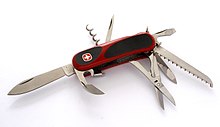
Back سكين سويسري Arabic İsveçrə bıçağı Azerbaijani Швейцарско ножче Bulgarian সুইস আর্মি ছুরি Bengali/Bangla Švicarski nož BS Navalla suïssa Catalan چەقۆی سویسڕی CKB Schweizerkniv Danish Schweizer Taschenmesser German Svisa tranĉilo Esperanto


The Swiss Army knife (SAK) is a pocketknife, generally multi-tooled, now manufactured by Victorinox.[1] The term "Swiss Army knife" was coined by American soldiers after World War II after they had trouble pronouncing the German word "Offiziersmesser", meaning "officer’s knife".[2]
The Swiss Army knife generally has a drop-point main blade plus other types of blades and tools, such as a screwdriver, a can opener, a saw blade, a pair of scissors, and many others. These are folded into the handle of the knife through a pivot point mechanism. The handle is traditionally a red colour, with either a Victorinox or Wenger "cross" logo or, for Swiss military issue knives, the coat of arms of Switzerland. Other colours, textures, and shapes have appeared over the years.
Originating in Ibach, Switzerland, the Swiss Army knife was first produced in 1891 when the Karl Elsener company, which later became Victorinox, won the contract to produce the Swiss Army's Modell 1890 knife from the previous German manufacturer. In 1893, the Swiss cutlery company Paul Boéchat & Cie, which later became Wenger SA, received its first contract from the Swiss military to produce model 1890 knives; the two companies split the initial contract for provision of the knives and operated as separate enterprises from 1908. In 2005 Victorinox acquired Wenger. As an icon of the culture of Switzerland, both the design and the versatility of the knife have worldwide recognition.[3] The term "Swiss Army knife" has acquired usage as a figure of speech indicating a multifaceted skillset.
- ^ French: couteau suisse: "Swiss knife", German: Schweizer Offiziersmesser: "Swiss officer's knife", Swiss Standard German: Sackmesser: "Pocket knife", Italian: Coltellino svizzero: "Swiss pocket knife"
- ^ "Victorinox Swiss Army Knives Info". Victorinox. Retrieved 18 September 2008.
- ^ Foulkes, Imogen (30 July 2009). "From humble tool to global icon". BBC News. Retrieved 31 October 2011.
© MMXXIII Rich X Search. We shall prevail. All rights reserved. Rich X Search